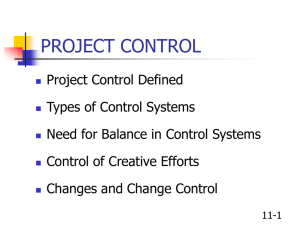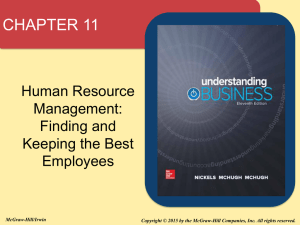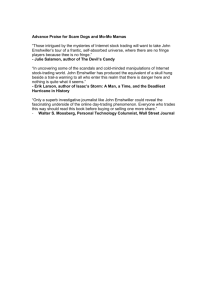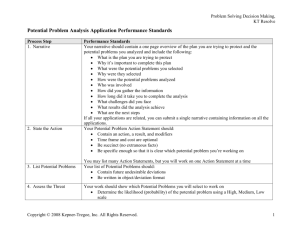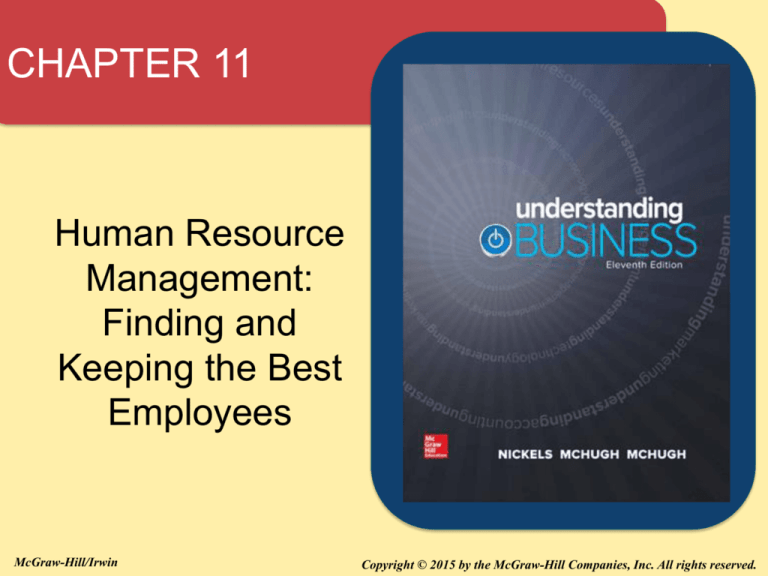
CHAPTER 11
Human Resource
Management:
Finding and
Keeping the Best
Employees
McGraw-Hill/Irwin
Copyright © 2015 by the McGraw-Hill Companies, Inc. All rights reserved.
LEARNING OBJECTIVES
1. Explain the importance of human resource
management, and describe current issues in
managing human resources.
2. Illustrate the effects of legislation on human resource
management.
3. Summarize the five steps in human resource
planning.
4. Describe methods that companies use to recruit new
employees, and explain some of the issues that
make recruitment challenging.
11-2
LEARNING OBJECTIVES
5. Outline the six steps in selecting employees.
6. Illustrate employee training and development
methods.
7. Trace the six steps in appraising employee
performance.
8. Summarize the objectives of employee
compensation programs, and evaluate pay systems
and fringe benefits.
11-3
LEARNING OBJECTIVES
9. Demonstrate how managers use scheduling plans
to adapt to workers’ needs.
10. Describe how employees can move through a
company: promotion, reassignment, termination,
and retirement.
11-4
TONY HSIEH
Zappos
• Hsieh sold his first company to
Microsoft for $265 million,
before becoming Zappos’ CEO.
• Changed Zappos’ corporate
work environment so reps wow
customers.
• The work environment is kept
open and accessible.
11-5
NAME that COMPANY
This company manages its global workforce of
about 100,000 employees and 100,000
subcontractors with a database that matches
employee skills, experiences, schedules, and
references with jobs available.
Name that company!
11-6
HUMAN RESOURCE
MANAGEMENT
LO 11-1
• Human Resource Management (HRM) -- The
process of determining human resource needs and
then recruiting, selecting, developing, motivating,
evaluating, compensating and scheduling employees
to achieve organizational goals.
• HRM’s role has grown because of:
1. Increased recognition of employees as a
resource.
2. Changes in law that rewrote old workplace
practices.
11-7
HUMAN RESOURCE MANAGEMENT
LO 11-1
11-8
UNCOVERING the
SECRETS of HRM
LO 11-1
Things Your HR Manager Doesn’t Tell You
• We’re short-staffed and under pressure too.
• We’re not always going to be able to help in the
way you hope.
• We can help you move up the career ladder.
• What you post on Facebook can get you fired.
Source: Smart Money, www.smartmoney.com, accessed November 2014.
11-9
DEVELOPING the FIRM’S
ULTIMATE RESOURCE
LO 11-1
• Service and high-tech manufacturing requires
employees with highly technical job skills.
• Such workers are scarce,
making recruiting and
retention more important
and more difficult.
• The human resource job is
now the job of all managers
in an organization.
11-10
CHALLENGES in FINDING
HIGH-LEVEL WORKERS
LO 11-1
• A shortage of trained workers in key areas
• Worker shortage in skilled trades
• An increasing number of baby boomers who
delay retirement
• A declining economy with fewer full-time jobs
• Expanding global markets with low-wage
workers
• Increasing benefit demands and benefit costs
• A decreased sense of employee loyalty
11-11
CIVIL RIGHTS ACT of 1964
LO 11-2
• Title VII prohibits discrimination in hiring, firing,
compensation, apprenticeships, training, terms,
conditions or privileges of employment based on:
- Race
- Religion
- Creed
- Sex
- Age
- National Origin
11-12
1972 EQUAL EMPLOYMENT
OPPORTUNITY ACT (EEOA)
LO 11-2
• Strengthened the Equal Employment Opportunity
Commission (EEOC).
• Gave EEOC the right to issue workplace
guidelines for acceptable employer conduct.
• EEOC could mandate specific recordkeeping
procedures.
• EEOC was vested with the power of enforcement.
11-13
CONTROVERSIAL PROCEDURES
of the EEOC
LO 11-2
• Affirmative Action -- Policy designed to “right past
wrongs” by increasing opportunities for minorities and
women.
• Reverse Discrimination -- Discriminating against
members of a dominant or majority group (e.g. whites
or males) usually as a result of policies designed to
correct previous discrimination against minority or
disadvantaged groups.
• This policy has been at the center of many
debates and lawsuits.
11-14
CIVIL RIGHTS ACT of 1991
and OFCCP
LO 11-2
• Civil Rights Act of 1991
- Amended Title VII and gave victims of
discrimination the right to a jury trial and possible
damages.
• Office of Federal Contract Compliance Programs
(OFCCP)
- Ensures that employers doing business with the
federal government comply with the
nondiscrimination and affirmative action laws.
11-15
LAWS PROTECTING
EMPLOYEES with DISABILITIES
LO 11-2
• Americans with Disabilities Act of 1990 (ADA)
- Requires employers to give applicants with physical or
mental disabilities the same consideration for employment as
people without disabilities.
- Passage in 2008 of Americans with
Disabilities Amendments Act
expanded protection.
- 2011 saw regulations that widen the
range of disabilities covered by the
ADA and shift the burden of proof of
disability from employees to
employers.
11-16
AGE DISCRIMINATION in
EMPLOYMENT ACT (ADEA)
LO 11-2
• Age Discrimination in Employment Act (ADEA)
- Protects workers 40 and
over from employment
and workplace
discrimination in hiring,
firing, promotion, layoff,
compensation, benefits,
job assignments and
training.
11-17
MINDING the LAW in HRM
LO 11-2
• Employers must know the law
and act accordingly.
• Legislation affects all areas of
HRM.
• Court cases highlight that
sometimes it’s proper to go
beyond providing equal rights.
• Changes in law and legislation
occur regularly.
11-18
TEST PREP
• What’s human resource management?
• What did Title VII of the Civil Rights Act of 1964
achieve?
• What’s the EEOC and what was the intention of
affirmative action?
• What does accommodations mean in the
Americans with Disabilities Act of 1990?
11-19
HUMAN RESOURCE PLANNING
PROCESS
LO 11-3
1) Preparing a human resource
inventory of employees.
2) Preparing a job analysis.
3) Assessing future human
resource demand.
4) Assessing future labor
supply.
5) Establishing a strategic plan.
11-20
WHAT’S a JOB ANALYSIS?
LO 11-3
• Job Analysis – A study of what employees do who
hold various job titles.
• Job Description – A summary of the objectives of
the job, the type of work, the responsibilities and
duties, working conditions and relationship to other
jobs.
• Job Specifications -- A summary of the minimum
qualifications needed to do a particular job.
11-21
RECRUITING EMPLOYEES
LO 11-4
• Recruitment -- The set of activities for obtaining the
right number of qualified people at the right time.
• Human resource managers use both internal and
external sources to recruit employees.
• Small businesses often make use of web
sources like CareerBuilder and Monster to
recruit employees.
11-22
COMPETING for the
CREAM of the CROP
• To survive, small businesses must recruit and
retain qualified workers.
• Unfortunately, they lack the resources of larger
companies to compete for employees.
• Small businesses need innovations like:
- Letting staff help recruit and select candidates.
- Audition an employee.
- Seek out publicity.
11-23
EMPLOYEE SOURCES
LO 11-4
11-24
SELECTION
LO 11-5
• Selection -- The process of
gathering information and
deciding who should be hired,
under legal guidelines, to
serve the best interest of the
individual and the
organization.
11-25
STEPS in the
SELECTION PROCESS
LO 11-5
1. Obtaining complete application forms
2. Conducting initial and follow-up interviews
3. Giving employment tests
4. Conducting background investigations
5. Obtaining results from physical exams
6. Establishing trial (probationary) work periods
11-26
OOPS!
LO 11-5
Areas Where Job Applicants Make Mistakes
Source: USA Today.
11-27
KEEPING the RIGHT FACE
on FACEBOOK
• Your online personality be appealing to
employers.
• Some of the worst things to do are:
- Posting provocative or inappropriate photos.
- Information on drug use or excessive drinking.
- Bad mouthing a previous employer.
- Discriminatory comments related to race, gender,
religion, etc.
11-28
HIRING CONTINGENT WORKERS
LO 11-5
• Contingent Workers -- Include part-time and
temporary workers, seasonal workers, independent
contractors, interns and co-op students.
• There are about 5.7
million contingent
workers in the U.S.
• Majority of contingent
workers are under 25.
11-29
WHY HIRE
CONTINGENT WORKERS?
LO 11-5
• Companies hire contingent workers:
- When full-time workers are on leave.
- During periods of peak demand.
- In uncertain economic times.
- To save on employee benefits.
- To screen candidates for future employment.
11-30
STUDENTS and the
CONTINGENT WORKFORCE
LO 11-5
• With temporary staffing agencies, companies
have easier access to screened workers.
• Worker information is entered into their
databases.
• When students come back
to town, they can call the
agency and ask them to
put their names into the
system for work.
11-31
INTERN or
INDENTURED SERVANT?
• With few entry-level positions available, interns
can end up in an unpaid position for as long as
six months with no chance of advancement.
• Some businesses give interns lots of
responsibility; a Toronto paper fired all paid staff
and replaced them with unpaid interns.
• Is it ethical for companies to use unpaid interns if
they know they don’t have jobs to offer or if the
unpaid internships replace paid jobs?
11-32
TEST PREP
• What are the five steps in human resource
planning?
• What factors make it difficult to recruit qualified
employees?
• What are the six steps in the selection process?
• Who is considered a contingent worker, and why
do company hire such workers?
11-33
TRAINING and DEVELOPING
EMPLOYEES
LO 11-6
• Training and Development -All attempts to improve
productivity by increasing an
employee’s ability to perform.
• Training focuses on short-term
skills.
• Development focuses on longterm abilities.
11-34
THREE STEPS of TRAINING
and DEVELOPMENT
LO 11-6
1. Assessing organization needs and employee
skills to develop appropriate training needs.
2. Designing training activities to meet identified
needs.
3. Evaluating the training’s effectiveness.
11-35
MOST COMMONLY USED TRAINING
and DEVELOPMENT ACTIVITIES
LO 11-6
• Orientation
• On-the-Job Training
• Apprenticeships
• Off-the-Job Training
• Online Training
• Vestibule Training
• Job Simulation
11-36
DEVELOPING EFFECTIVE
MANAGERS
LO 11-6
• Management Development -- The process of
training and educating employees to become good
managers and monitoring the progress of their skills
over time.
• Management training includes:
- On-the-job coaching
- Understudy positions
- Job rotation
- Off-the-job courses and training
11-37
WHY GOOD EMPLOYEES QUIT
Source: Robert Half International
LO 11-6
11-38
USING NETWORKS and
MENTORING
LO 11-6
• Networking -- Establishing and maintaining contacts
with key managers in and out of the organization and
using those contacts to develop relationships.
• Mentors -- Managers who supervise, coach and
guide selected lower-level employees by acting as
corporate sponsors.
• Networking and mentoring go beyond the work
environment.
11-39
APPRAISING PERFORMANCE
on the JOB
LO 11-7
• Performance Appraisal -- An evaluation that
measures employee performance against established
standards in order to make decisions about
promotions, compensation, training or termination.
• A 360-degree review
gives managers
opinions from people at
different levels to get a
more accurate idea of
the worker’s ability.
11-40
SIX STEPS of PERFORMANCE
APPRAISALS
LO 11-7
1. Establishing performance standards that are
understandable, measurable and reasonable.
2. Clearly communicating those standards.
3. Evaluating performance against the standards.
4. Discussing the results with employees.
5. Taking corrective action.
6. Using the results to make decisions.
11-41
DOs and DON’Ts of
PERFORMANCE APPRAISALS
LO 11-7
11-42
MAJOR USES of
PERFORMANCE APPRAISALS
LO 11-7
• Identify training needs
• Use as a promotion tool
• Recognize worker’s achievements
• Evaluate the firm’s hiring process
• Judge the effectiveness of the firm’s orientation
process
• Use as a basis for possible termination of a
worker
11-43
PERFORMANCE APPRAISAL
MISTAKES
LO 11-7
Common Problems Made While Reviewing Employees
• Contrast Effect - Comparing one employee to
another.
• Halo/Horn Effect - Allowing performances in specific
areas to unfairly influence overall performance
evaluation.
• Similar-to-Me Effect - Generosity to those you feel
are more like you.
11-44
TEST PREP
• Name and describe four training techniques.
• What’s the primary purpose of a performance
appraisal?
• What are the six steps in a performance
appraisal?
11-45
COMPENSATION PROGRAMS
LO 11-8
• A managed and competitive compensation
program helps:
- Attract the kinds of employees the business needs.
- Build employee incentive to work efficiently and
productively.
- Keep valued employees from going to competitors or
starting their own firm.
- Maintain a competitive market position by keeping costs
low due to high productivity from a satisfied workforce.
- Provide employee financial security through wages and
fringe benefits.
11-46
TYPES of PAY SYSTEMS
LO 11-8
11-47
TYPES of PAY SYSTEMS
LO 11-8
11-48
TYPES of PAY SYSTEMS
LO 11-8
11-49
COMPENSATING TEAMS
LO 11-8
• Team-based pay programs are more challenging
than individual pay systems.
• The two most common methods for teams
involve:
- Skill-Based: Pay is increased as skill increases.
(Eastman Chemical uses this system.)
- Gain-Sharing: Pay is increased as performance
increases. (Nucor Steel uses this system.)
11-50
FRINGE BENEFITS on the JOB
LO 11-8
• Fringe Benefits -- Sick leave, vacation pay, pension
and health plans that provide additional compensation
to employees beyond base wages.
• In 1929, fringe benefits accounted for less than
2% of payroll cost. Today it’s about 30%.
• Healthcare has been the most significant increase
in fringe benefit cost.
11-51
HEALTHCARE, a PERK NOT
to be TAKEN LIGHTLY
LO 11-8
• Compare all the costs, not
just premiums.
• Take part in wellness
programs. The average
wellness bonus is $386!
• Order generic drugs when
you need prescriptions filled.
Source: Kiplinger’s Personal Finance, November 2010.
11-52
WHO PAYS for
EMPLOYEE BENEFITS?
LO 11-8
• 74% of full-time workers
have employee-provided
retirement plans.
• 39% of part-time workers
have employee-provided
retirement plans.
• 71% of workers have
medical care benefits.
Source: Entrepreneur, www.entrepreneur.com, accessed November 2014.
11-53
The RANGE of
FRINGE BENEFITS
LO 11-8
• Fringe benefits include incentives like:
- Company cars
- Country club memberships
- Recreation facilities
- Special home mortgage rates
- Paid and unpaid sabbaticals
- Day-care and elder care services
- Dental and eye care
- Legal counseling
- Short or compressed work weeks
11-54
SPECIAL PERKS at
DREAMWORKS
LO 11-8
• Free DVDs and screenings
of current films.
• Free breakfast and lunch
plus dinner when working
late.
• Free snack rooms on every
floor.
• Profit sharing.
• Ping-Pong and poker
tournaments during work
hours.
11-55
CAFETERIA-STYLE and
SOFT BENEFITS
LO 11-8
• Cafeteria-Style Fringe Benefits -- Allow
employees to choose the benefits they want (up to a
certain dollar amount).
• Soft Benefits include:
- Onsite haircuts and shoe repair
- Concierge services
- Free meals at work
- Doggie daycare
- Onsite farmer’s markets
11-56
LET’S GO to the BEACH!
LO 11-8
Average Vacation Days by Country
Source: Reuters, June 24, 2010.
11-57
CULTURAL CHALLENGES
without CONFLICT
• Managers need to understand the business
needs of each country they operate in.
- Compensation: Conversion to foreign currencies and
special allowances often are needed.
- Health and Pension Standards: Benefits are different
country-by-country.
- Paid Time Off: Vacation time, sick and personal leave
vary.
- Taxation: Tax policies vary.
- Communication: Employees can feel disconnected in
other countries.
11-58
FLEXIBLE SCHEDULING PLANS
LO 11-9
• Flextime Plan -- Gives employees some freedom to
choose which hours to work as long as they work the
required number of hours or complete their tasks.
• Compressed Work Week -- Employees work the
full number of work hours, but in fewer than the
standard number of days.
• Job Sharing -- Lets two or more part-time
employees share on a full-time job.
11-59
USING FLEXTIME PLANS
LO 11-9
• Most flextime plans require Core Time -- When all
employees are expected to be at their job stations.
• Flextime is difficult to incorporate into shift work
and managers have to work longer hours.
• Communication among employees can also be
difficult under flextime and managers have to be
alert to any system abuses.
11-60
A FLEXTIME CHART
LO 11-9
11-61
COMPRESSED WORK WEEKS
LO 11-9
• Employees enjoy long
weekends after working long
days.
• Productivity is a concern.
• Nurses and firefighters often
work compressed work
weeks.
11-62
HOME-BASED WORK
LO 11-9
• About 13 million Americans work from home at
least several days a month.
• 12% of U.S. businesses use some home-based
work.
• Bank of America has
My Work that permits
employees to work
remotely about 60%
of the time.
11-63
HOME-BASED WORK
LO 11-9
11-64
VIRTUALLY THERE
LO 11-9
Tools to Help You Work From Home
• Communication:
- Google Apps
- Skype
- Yammer
• Collaboration:
- Google Docs
- GoToMeeting
- Dropbox
11-65
GOING NOWHERE FAST
LO 11-9
Worst Commutes in the World
Source: Bloomberg Businessweek, www.businessweek.com, accessed November 2014.
11-66
JOB SHARING BENEFITS
LO 11-9
• Provides employment opportunities for many
people who cannot work full time.
• Workers tend to be enthusiastic and productive.
• Absenteeism and tardiness are reduced.
• Employers can schedule part-time workers in
peak demand periods.
11-67
MOVING EMPLOYEES
LO 11-10
• Employees are promoted or reassigned.
• Employees are terminated due to
performance or economic situations.
• Employees retire.
11-68
TERMINATING EMPLOYEES
LO 11-10
• As the economic crisis grew, more and more
employers have had to lay off employees.
• Even when the economy is booming, employers
are hesitant to hire full-time workers because of
the cost of termination.
• Firing employees is more
difficult for employers because
of laws preventing termination
for certain acts.
11-69
PLAYING HOOKY
LO 11-9
Crazy Excuses for Missing Work
• I woke up in a good mood and didn’t want to ruin it.
• I just put a casserole in the oven.
• I caught my uniform on fire by putting it in the
microwave to dry
• I had been at the casino all weekend and still had
money left to play with on Monday morning.
• I accidentally got on a plane.
Source: Forbes, www.forbes.com, accessed November 2014.
11-70
TEST PREP
• Name and describe five alternative compensation
techniques.
• What advantages do compensation plans such
as profit sharing offer an organization?
• What are the benefits and challenges of flextime?
Telecommuting? Job sharing?
11-71

